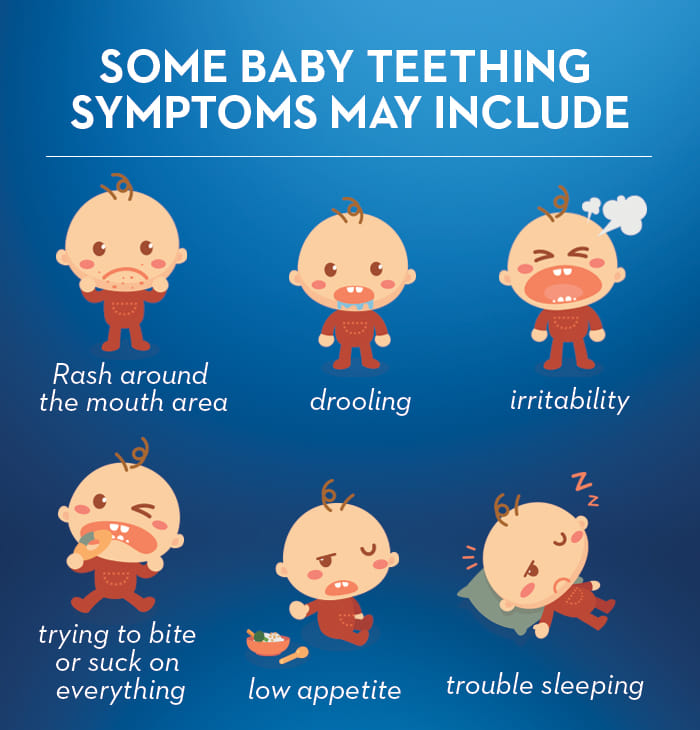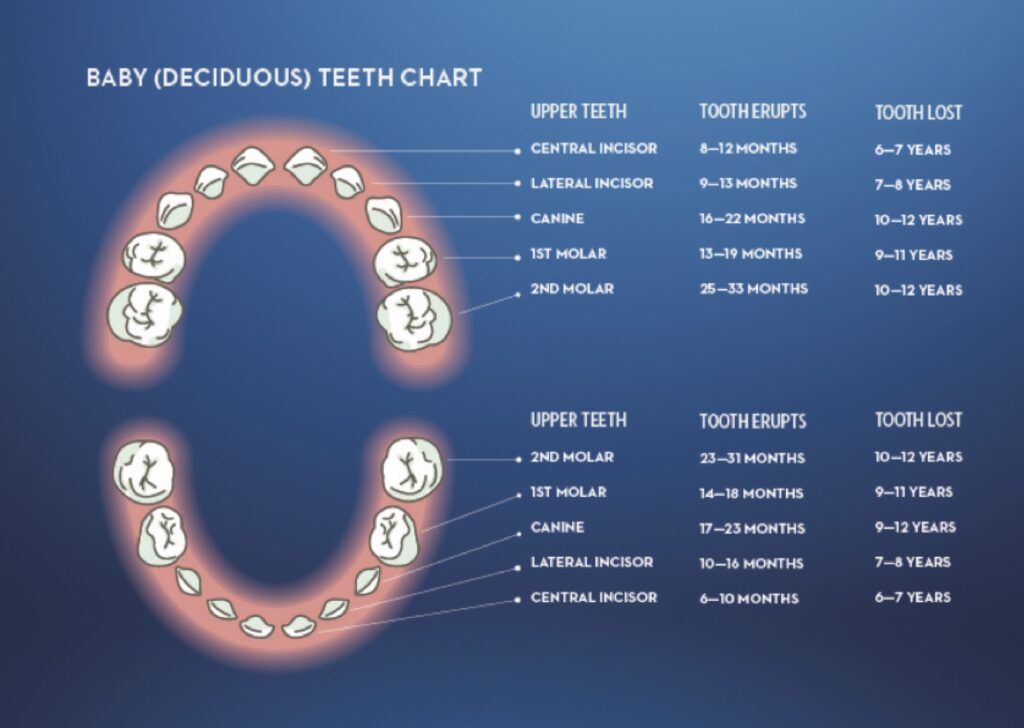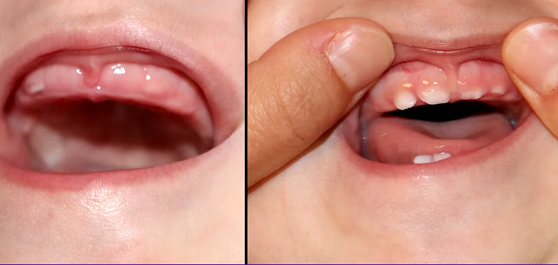Baby Teething is a natural process that every baby goes through, but it can also be very uncomfortable and distressing for both the baby and the parents. Teething usually starts when the baby is around 6 months young, but it can vary from one child to another. Some babies may show signs of teething earlier or later than others, and some may have more or less symptoms than others.
Teething symptoms include drooling, biting, irritability, fussiness, difficulty sleeping, loss of appetite, swollen gums, and sometimes fever or diarrhea. These symptoms can last for several days or weeks, depending on how fast the teeth erupt and how many teeth are coming in at once.
If you are looking for some baby teething tips to help your little one cope with the pain and discomfort of teething, you have come to the right place. In this blog post, we will share with you some of the best ways to soothe your baby’s teething pain and make this phase easier for both of you.

Image courtesy Crest
Table of Contents
Baby Teething Tips : How to massage your baby’s gums
One of the simplest and most effective Baby Teething tips is to massage your baby’s gums gently with your clean finger. This can help relieve the pressure and pain caused by the emerging teeth. You can also use a soft, damp cloth or a silicone finger brush to massage the gums. You can do this several times a day, especially before feeding or bedtime.
To make the massage more soothing, you can also apply some edible oil, such as coconut oil, olive oil, or chamomile oil, to your finger or cloth. These oils have anti-inflammatory and antibacterial properties that can help reduce the swelling and infection of the gums. However, make sure you use only a small amount of oil and avoid using any oil that your baby may be allergic to.
Baby Teething Tips : How to use cold or frozen items to numb the pain
Another common baby teething tip is to use cold or frozen items to numb the pain and inflammation of the gums. Cold items can constrict the blood vessels and reduce the sensitivity of the nerves in the gums. You can use a variety of cold items, such as:
- A chilled teething ring or toy. You can refrigerate a silicone or rubber teething ring or toy for a few minutes and then give it to your baby to chew on. Make sure the ring or toy is not too hard or too cold for your baby’s mouth. Avoid using metal or plastic rings or toys that may break or crack.
- A cold spoon. You can chill a metal spoon in the refrigerator and then gently rub it on your baby’s gums. Make sure the spoon is not too cold or too sharp for your baby’s mouth. Avoid using spoons that have any coating or paint that may peel off.
- A frozen washcloth or fruit. You can wet a clean washcloth and freeze it for a few minutes and then let your baby suck on it. You can also freeze some fruit, such as banana, apple, or melon, and put it in a mesh feeder for your baby to gnaw on. Make sure the washcloth or fruit is not too frozen or too large for your baby’s mouth. Avoid using any fruit that has seeds, pits, or skin that may pose a choking hazard.
Baby Teething Tips : How to choose the best teething toys and rings for your baby
Teething Toys and Rings are specially designed to help your baby cope with teething pain and discomfort. They are usually made of soft, flexible, and durable materials that can withstand your baby’s biting and chewing. They also come in different shapes, sizes, colors, and textures that can stimulate your baby’s senses and keep them entertained.
However, not all teething toys and rings are made equal. Some may contain harmful chemicals, such as BPA, PVC, phthalates, lead, or cadmium, that can leach into your baby’s mouth and cause health problems. Some may also have small parts, such as beads, buttons, or batteries, that can break off and cause choking or injury.

Factors to consider when choosing teething toys and rings for your baby
- They are made of natural, organic, or non-toxic materials, such as wood, silicone, rubber, cotton, or bamboo.
- They are free of any chemicals, paints, dyes, coatings, glues, or fillers that may be harmful to your baby.
- They are easy to clean and sterilize with soap and water or boiling water.
- They are appropriate for your baby’s age and stage of development.
- They are comfortable and safe for your baby’s mouth and teeth.
Baby Teething Tips : How to avoid potential hazards and risks when using teething remedies
While using teething remedies can help your baby feel better, you should also be aware of the potential hazards and risks that may come with them. Some of the things you should avoid or be careful about are:
- Over-the-counter teething gels or creams. These products may contain benzocaine, lidocaine, or other numbing agents that can cause serious side effects, such as allergic reactions, methemoglobinemia, or seizures, in your baby. The FDA has warned against using these products for children under 2 years old. If you want to use a topical product for your baby’s gums, you should consult your paediatrician or dentist first and use only a small amount as directed.
- Teething necklaces or bracelets. These are jewellery items that are worn by the baby or the parent to supposedly provide relief from teething pain. They may be made of amber, silicone, wood, or other materials. However, these items pose a choking, strangulation, or infection risk for your baby. There is no scientific evidence that they work, and the AAP and the FDA have advised against using them.
- Homeopathic teething tablets or drops. These are products that claim to use natural ingredients, such as chamomile, belladonna, or calcarea phosphorica, to ease teething symptoms. However, these products may contain inconsistent or unsafe amounts of these ingredients that can cause adverse reactions, such as seizures, breathing problems, or liver damage, in your baby. The FDA has issued warnings and recalls for several of these products. You should avoid using these products unless prescribed by your doctor.
Baby Teething Tips : How to use natural or home remedies to ease the inflammation and irritation
If you prefer to use natural or home remedies to ease your baby’s teething pain and discomfort, you should do so with caution and under the guidance of your doctor. Some of the natural or home remedies that may help your baby are:
- Chamomile tea: Chamomile is a herb that has anti-inflammatory and calming properties that can help reduce the swelling and irritation of the gums and soothe your baby’s mood. You can brew some chamomile tea and let it cool down before giving it to your baby in a bottle or a cup. You can also soak a washcloth in chamomile tea and freeze it for your baby to chew on.
- Clove oil: Clove is a spice that has analgesic and antiseptic properties that can help numb the pain and prevent infection of the gums. You can dilute some clove oil with a carrier oil, such as coconut oil or olive oil, and apply it to your baby’s gums with a cotton swab. You can also add some clove oil to a warm compress and place it on your baby’s cheek.
- Vanilla extract: Vanilla is a flavouring agent that has soothing and relaxing effects that can help calm your baby’s nerves and reduce their stress. You can rub some vanilla extract on your baby’s gums with your finger or a cotton swab. You can also add some vanilla extract to a bottle of water or milk for your baby to drink.

Image courtesy Crest
Baby Teething Tips : When to consult your paediatrician or dentist if you have any concerns or questions
While teething is a normal and harmless process for most babies, sometimes it may cause complications or indicate underlying problems that require medical attention. Some of the signs that you should consult your paediatrician or dentist are:
- Your baby has a fever higher than 100.4°F (38°C) for more than 24 hours.
- Your baby has diarrhoea, vomiting, rash, earache, cough, or other symptoms that are not related to teething.
- Your baby has bleeding, pus, redness, or foul smell in their gums or mouth.
- Your baby has difficulty breathing, swallowing, or feeding.
- Your baby has no teeth by 18 months old or has more than 20 teeth by 30 months old.
Your paediatrician or dentist can examine your baby’s mouth and teeth and diagnose any problems or infections that may need treatment. They can also advise you on how to care for your baby’s oral health and hygiene and when to start brushing their teeth.
Also read Soft Bristle Toothbrush – A Must Have for Your Oral Health.
Conclusion
Teething is a milestone in your baby’s development that can bring some challenges and discomforts for both of you. However, by following these baby teething tips, you can help your baby get through this phase with less pain and more smiles.
Remember to always use teething remedies with caution and supervision and consult your doctor if you have any doubts or concerns. And don’t forget to enjoy this precious time with your little one as they grow their first set of pearly whites!
If you have any questions or comments, please feel free to share them with us. We would love to hear from you! 😊

1 thought on “Baby Teething Tips: How to Soothe Your Little One’s Pain”